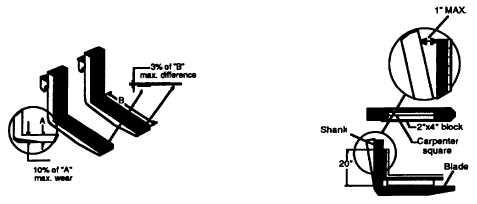| |
TM 10-3930-671-24
Forks
NOTE
•
If the fork blade at the heel is worn down
by more than 10%, the load capacity is
reduced and the fork must be replaced.
•
If the fork blades are obviously bent or
damaged, have them inspected by a
trained maintenance person.
1. Inspect the load forks for cracks, breaks,
bending, and wear. Move the forks together
side-by-side. The fork top surfaces should be
level and even with each other. The height
difference between both fork tops should be no
more than 3% of the fork length. Replace bent
forks.
2. At each PM interval, an inspection of the forks
must be made to check for wear. Check the
amount of wear at the heel of the fork. See
Table 1 below.
3. Inspect the forks for twists and bends.
To Check - Put a 2' thick metal block, at least 4" wide by
24” long, on the blade of the fork with the 4" surface
against the blade.
Put a 24” carpenter square on the top of the block and
against the shank.
Check the fork 20” above the blade to be sure it is not
bent more than 1-inch maximum.
Table 1. Fork Wear Chart
NOTE
The % capacity reductions are based upon wear only. Other factors such as cracks, cuts,
holes, etc., may further reduce the capacity of the fork
Allowable wear of fork thickness at heel of fork:
10% Wear:
Forks must be scheduled for replacement. With 10% wear, the forks are
adequate for only approximately 80% of rated capacity. Forks may be
used only until replacements are available.
20% Wear:
Forks are unsafe and must be removed from service immediately.
NEW
REPLACE
SAFETY HAZARD
Standard Fork
Nominal 10% Wear
Nominal 20% Wear
Thickness, Inches
Thickness, Inches
Thickness, Inches
1.25
1.12
1.00
1.50
1.38
1.19
1.75
1.56
1.38
2.00
1.81
1.62
2.25
2.00
1.81
2.50
2.25
2.00
F-43
|

